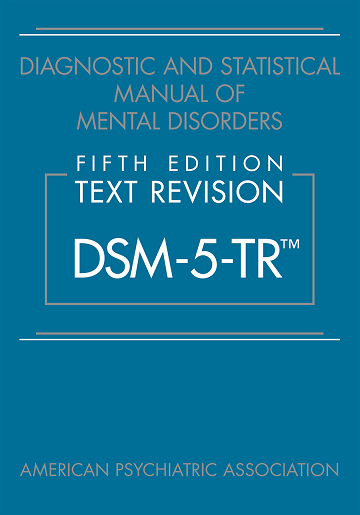Autism Spectrum Disorder in DSMs and ICDs
Autism Spectrum Disorder in DSMs and ICDs
The American Psychiatric Association (APA) released the Diagnostic and Statistical Manual of Mental Disorders, 5th edition Text Revision – known as the DSM-5-TR – in October 2022. The text changes are minor.
They released the previous version — known as the DSM-5 — on 13-May-2013. The 5th edition changed the formal name for "autism" to Autism Spectrum Disorder (ASD) from the group of names used in the DSM-IV (Pervasive Developmental Disorder, Autistic Disorder, Asperger's Disorder or PDD-NOS).

Note: the ICD-11 criteria for Autism Spectrum Disorders (note plural) is now available here. This page will be updated when we have the resources.
The table below shows related terms from the DSM-5-TR (current), the DSM-IV (superceded) and the World Health Organization's (WHO) ICD-10 ...
In relation to the DSM-IV and the ICD-10, the term, Autism Spectrum Disorders (note the plural) or ASDs, is a collective term for autism-related disorders. People using this term may or may not include the rarer conditions/disorders listed below. Clinicians in Australia use two references that describe ASD/PDD and its subtypes. The several references are:
- The Diagnostic and Statistical Manual of Mental Disorders, fifth edition 2013 (known as the DSM-5) is published by the American Psychiatric Association (APA). The text of the DSM-5 section on Autism Spectrum Disorder can be found online at http://www.autismspeaks.org/what-autism/diagnosis/dsm-5-diagnostic-crit…. The Diagnostic and Statistical Manual of Mental Disorders, fourth edition, 1994 (known as the DSM-IV) was published by the American Psychiatric Association (APA). There was also a "Text Revision" to this manual, usually known as the DSM-IV-TR, published in 2000.
- The World Health Organization publishes the International Statistical Classification of Diseases and Related Health Problems, tenth revision (ICD-10). The ICD-10 is available online: see http://apps.who.int/classifications/icd10/browse/2010/en#/F80-F89
The following table shows relationships between clinical terms and their sources.
| DSM-5 (2013-2022) DSM-5-TR (2022-) |
Pervasive Developmental Disorders | |
|---|---|---|
| DSM-IV (1994-2000) DSM-IV-TR (2000-2013) |
ICD-10 (1996-now) | |
| 299.00 Autism Spectrum Disorder | 299.00 Autistic Disorder | F84.0 Childhood Autism |
| 299.80 Asperger’s Disorder | F84.5 Asperger Syndrome | |
| 299.80 Pervasive Developmental Disorder - not otherwise specified (including Atypical Autism) — PDD-NOS | F84.1 Atypical Autism | |
| F84.8 Other pervasive developmental disorders | ||
| F84.9 Pervasive developmental disorders, unspecified | ||
| F84.4 Overactive disorder associated with mental retardation and stereotyped movements | ||
| 299.80 Rett’s Disorder | F84.2 Rett’s Syndrome | |
| 299.10 Childhood Disintegrative Disorder | F84.3 Childhood Disintegrative Disorder | |


The DSM-5-TR describes three "severity levels" to be associated with a diagnosis of Autism Spectrum Disorder. A DSM-5-TR diagnosis expects (requires?) two severity levels to be recorded/reported; the two levels are specifically for "Social communication" and "Restricted, repetitive behaviors". The levels are described as:
- Level 3 "Requiring very substantial support”
- Level 2 "Requiring substantial support”
- Level 1 "Requiring support”
In relation to updating how a person's diagnoses should be described, the DSM-5-TR say:
Individuals with a well-established DSM-IV diagnosis of autistic disorder, Asperger’s disorder, or pervasive developmental disorder not otherwise specified should be given the diagnosis of autism spectrum disorder. Individuals who have marked deficits in social communication, but whose symptoms do not otherwise meet criteria for autism spectrum disorder, should be evaluated for social (pragmatic) communication disorder.
The DSM-5-TR states categorically, emphatically and repeatedly that “The descriptive severity categories should not be used to determine eligibility for and provision of services; these can only be developed at an individual level and through discussion of personal priorities and targets”.
other terms
The simple term "autism" is not a formal term. It is a vague and imprecise term.
PDD-NOS in the DSM-IV includes F84.1, F84.8 and F84.9 from the ICD-10
The conditions labeled F84.2, F84.3 and F84.4 are considered rare. There is debate as to whether they are part of the Autism Spectrum.
“High-functioning Autism” (HFA) appears to mean Autistic Disorder (F84.0) with an IQ>70. It is not a formal category in any of these classifications.
The ICD-11 specifically exclude Rett syndrome (LD90.4) from ASDs; it is now in a Developmental anomalies, LD90 Conditions with disorders of intellectual development as a relevant clinical feature category.